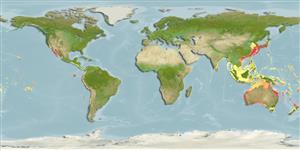>
Centrarchiformes (Basses) >
Microcanthidae (Stripeys)
Etymology: Microcanthus: Greek, mikros = small + Greek akantha = thorn (Ref. 45335); strigatus: Name from Latin 'strigatus' for strigate, referring to the transverse bands or streaks of colour.
More on author: Cuvier.
Environment: milieu / climate zone / depth range / distribution range
Ecologie
marien; brak water rifbewoner; oceanodroom (Ref. 51243); diepte 1 - 140 m (Ref. 58302). Tropical
Indo-Pacific: East Asia (southern Japan, Korea, the eastern coast of China, Taiwan and Hong Kong), Hawaii and Western Australia.
Grootte / Gewicht / Leeftijd
Maturity: Lm ? range ? - ? cm
Max length : 16.2 cm FL mannelijk / geslacht onbekend; (Ref. 131261); max. gepubliceerd gewicht: 135.00 g (Ref. 131261)
Korte beschrijving
Determinatiesleutels | Morfologie | Morfometrie
Dorsale stekels (totaal) : 11; Dorsale zachte stralen (totaal) : 15 - 17; Anale stekels: 3; Anale zachte stralen: 13 - 15. This species is distinguished by the following set of characters: coloration - fifth body stripe inflected toward the anal fin origin at an angle of 120-150° (usually 130°); lower abdomen usually with a broken stripe, as a series of 2-5 (usually 3) spots and short dashes (Ref. 123714).
Benthopelagic (Ref. 58302). Inhabits coastal and lagoon reefs, also in dense aggregations under ledges and in caves during the day (Ref. 9710). Also observed in rocky areas and occasionally in harbours, embankments, and coastal ports. Adults often school in large groups. It ranges between 10 and 30 m depth, but can occur as shallow as 0.3 m to as deep as 300 m (Ref. 123714). Young feeds on small crustaceans and algae (Ref. 3921).
Levenscyclus en paargedrag
Maturiteit | Voortplanting | Paaien | Eieren | Fecunditeit | Larven
Tea, Y.K. and A.C. Gill, 2020. Systematic reappraisal of the anti-equatorial fish genus Microcanthus Swainson (Teleostei: Microcanthidae), with redescription and resurrection of Microcanthus joyceae Whitley. Zootaxa 4802(1):41-60. (Ref. 123714)
Status op de Rode Lijst van het IUCN (Ref. 130435: Version 2024-1)
Gevaar voor de mens
Harmless
Gebruik door de mens
Visserij: commercieel; Aquarium: Commercieel
Tools
Speciale rapporten
Download XML
Internetbronnen
Estimates based on models
Preferred temperature (Ref.
123201): 17.5 - 26.4, mean 23.7 °C (based on 254 cells).
Fylogenetische diversiteitsindex (Ref.
82804): PD
50 = 1.0000 [Uniqueness, from 0.5 = low to 2.0 = high].
Bayesian length-weight: a=0.02344 (0.00909 - 0.06048), b=2.99 (2.76 - 3.22), in cm total length, based on LWR estimates for this (Sub)family-body shape (Ref.
93245).
Trofisch niveau (Ref.
69278): 3.0 ±0.35 se; based on food items.
Fishing Vulnerability (Ref.
59153): Low vulnerability (10 of 100).
Nutrients (Ref.
124155): Calcium = 81 [39, 129] mg/100g; Iron = 0.685 [0.418, 1.164] mg/100g; Protein = 18.6 [17.4, 19.7] %; Omega3 = 0.143 [0.086, 0.239] g/100g; Selenium = 34.9 [17.7, 67.9] μg/100g; VitaminA = 64 [17, 233] μg/100g; Zinc = 1.63 [1.11, 2.35] mg/100g (wet weight);
